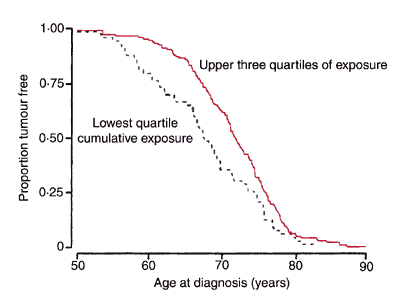Positive Health Online
Your Country

The Life and Cancer Protecting Properties of Sunlight
listed in cancer, originally published in issue 81 - October 2002
Introduction
The Ebers Papyrus, one of the oldest surviving Egyptian medical texts, recommends exposure to the sun,[1] and some of the most distinguished figures in Greek, Roman and Islamic medicine used sunlight to prevent and cure disease. The Nobel Prize for Medicine was awarded to a sunlight therapist in 1903, and the sun's rays were used to disinfect and heal the wounds of casualties during the First World War. Before antibiotics became widely available, sunlight therapy was used to treat tuberculosis and other diseases, and special hospitals were built so that solar radiation could be administered to patients under medical supervision.[2]
Today, sunlight has fallen from favour to such an extent that there are now annual health campaigns that stress the dangers of sunbathing, and an entire industry has emerged to protect us from the sun's ultraviolet rays. But, paradoxically, the ultraviolet rays that cause tanning and burning are the same ones that have a therapeutic effect, and they are our natural source of vitamin D.

The History of Vitamin D Deficiency
Unfortunately, health campaigns promoting the idea that sun exposure is fundamentally harmful cause undue anxiety about sunbathing, and inevitably contribute to the prevalence of vitamin D deficiency. This is known to be endemic among the older population,[3] and may be a problem across all age groups. History shows that when physicians turn away from the sun the consequences for public health can be very severe. This was certainly the case during the Industrial Revolution, when little importance was attached to the beneficial effects of sunlight exposure, and high levels of air pollution in industrial towns and cities blocked out the sun's rays. Children living in urban areas were susceptible to the bone disease rickets, which became endemic in England during the eighteenth century and was to remain so for more than 200 years.
Rickets usually develops between the ages of nine months and two years and is the result of vitamin D deficiency. The symptoms include deformities of the limbs and spine, bad teeth and muscle weakness. Although rarely fatal in itself, it resulted in high rates of infant and maternal deaths.[4] Women who developed the disease in childhood often had deformities of the pelvis, which made childbirth very hazardous, while rachitic children had an increased susceptibility to infectious diseases. In 1915, an examination of schoolchildren in the East End of London found that 80% were affected by rickets, and studies in other countries showed similar results.[5] Yet there was still a great deal of confusion as to the cause and, unfortunately, no one within the mainstream of medical research had considered sunlight deprivation to be a factor. A number of theories were put forward in an attempt to explain why rickets was so common: one was that it was an hereditary disease; another that it was the result of a bad diet; a third was that it was due to syphilis or some other infection. Then there was the `domestication' theory, which held that rickets was due to a combination of confinement indoors and bad hygiene. Some physicians attributed it to a lack of fresh air and exercise, while others argued that rickets was caused by "changes in internal secretions".[6] The Medical Research Committee of Great Britain reviewed these and other theories during the course of a detailed investigation of rickets, the results of which were published in 1918. They reached the following conclusion: "…in spite of the most varied and extensive research we have practically no real knowledge of the nature or causation of this widespread malady or the factors which determine its onset."[7]
Yet the disease was well known as a seasonal condition which developed in the winter months and which healed in the summer. In addition, the relationship between rickets and sunlight exposure was documented. In 1815, the French physician Cauvain had recommended sunlight as a treatment for rickets.[8] Then in 1822 the Polish physiologist Sniadecki wrote of the importance of the sun's rays in preventing and curing the `English Disease' as it had become known on the Continent.[9] Subsequently Dr Theobald Palm, a general practitioner in Cumbria, surveyed the geographical distribution of rickets and in 1890 published his conclusion that the disease occurred as a result of deprivation of sunlight.[10] Palm advocated sunbathing as a preventive and therapeutic measure for rickets, as did the Swiss physician Professor Auguste Rollier, who published a book on sunlight therapy in 1916 in which he wrote that "the sun cure is without doubt the treatment of choice in rickets".[1]1
It was not to be until 1921 that scientists showed, to nearly everyone's satisfaction, that rickets develops when children are deprived of sunlight and that sunbathing cures it.[12] Why this was ignored for so long in spite of compelling scientific and circumstantial evidence has yet to be explained satisfactorily. But, given an oversight of this magnitude, it is rather ironic that the discovery of the cause and cure of rickets is regarded as one of the great triumphs of modern medicine.[13] Doubly so, since the gradual elimination of rickets is usually attributed to the introduction of vitamin D supplements into the diet, rather than to the promotion of sunbathing as a public health measure which occurred from the 1920s onwards. Parents used to be told to put infants out in the sun at every opportunity. Now they are told to keep babies under 12 months out of direct sunlight and to put sunscreen on older children. Not surprisingly, there are reports that rickets is making an unwelcome return.[14]

Children were put out in the sun when they were at school
Sunlight Exposure and Disease
Cancer
There are some striking parallels between the history of rickets and a number of the major degenerative diseases that now hold the Western world in their grip. For example, it has been known for more than 50 years that death rates from major internal cancers increase with distance from the equator and also show an inverse association with sunlight exposure.[15] Several recent ecological studies suggest that sunlight exposure protects against breast, ovarian, prostate and colon cancer.[16-18] The first study to assess the relationship between sunlight exposure and breast cancer by looking at the behaviour of individual women was published in 1999. This showed that women who lived in the sunnier regions of the USA and had high levels of exposure to the sun reduced their risk of developing breast cancer by 25-65%.[19] Similarly, the protective effect of sunlight on prostate cancer risk has been confirmed in a recent study of men's behaviour in the sun. Sunbathing, regular foreign holidays and a history of childhood sunburn protect men from prostate cancer and can delay the onset of the disease.[20] Research also points increasingly to the important part played by vitamin D in the normal functioning of the immune system and in the growth and maturation of cells. Vitamin D has been shown to inhibit the growth and metastasis of cancer cells, particularly for breast, prostate and colon cancer.[21]
With health campaigns warning against sunbathing because of the risks of developing cancer, it is easy to see why the cancer inhibiting properties of sunlight have been largely overlooked. Certainly there has been little support for the hypothesis that sunlight inhibits the development of internal cancers from mainstream cancer researchers. This is not altogether surprising given the slowness with which the association between rickets and sunlight came to be accepted by much of the medical establishment.

Association of ultraviolet radiation exposure and age at diagnosis with prostate cancer.
Taken from Luscombe CJ, et al. The Lancet. Vol 358, August 25, 2001.
Osteoporosis
While rickets is no longer the problem it once was, the bone disease osteoporosis is becoming so common in Western countries as to be termed a `silent epidemic'. Osteoporosis affects one in three women over 50 in the UK and one in 12 men. Each year about 50,000 wrist fractures, 40,000 vertebral fractures and 60,000 hip fractures are diagnosed.[22] Some 20% of these hip fractures are followed by death and those who survive often suffer permanent disability. Bone quality is deteriorating among the older population, and low levels of vitamin D are implicated. Certainly many more lives are claimed each year by hip fractures than are claimed by skin cancer.
Heart Disease
The same may apply to heart disease. It has been known for more than half a century that exposure to ultraviolet light will lower blood pressure in normal individuals and can have an even more pronounced effect on individuals with high blood pressure. Published data show a linear rise in blood pressure at increasing distances from the equator.[23] They also show that geographic and seasonal changes in blood pressure are inversely associated with solar radiation. Not only does sunlight lower blood pressure and cholesterol levels, but the results of tests reported in the American Journal of Physiology in 1935 show that exposure to ultraviolet radiation can also increase the amount of blood ejected from the heart – the cardiac output – by as much as 39%.[24] If sunlight does influence the functioning of the heart to anything like this extent, one would expect to see more heart disease when and where there was less available solar radiation.
More people die of heart attacks in the winter than in the rest of the year and, as with internal cancers, deaths from heart disease become more common with increasing distance from the equator.[25] Blood cholesterol levels also increase with distance from the equator, and it is countries in the northwest of Europe, such as Britain, which have the highest cholesterol levels and deaths from heart disease. The highest incidence of heart disease in the British Isles is among less well-off families in Scotland, Northern Ireland and the north-west of England. Bad housing, minimal participation in outdoor activities such as gardening and insufficient money for holidays in sunlit places have been identified as reasons for lack of sunlight exposure in this high-risk group.[26]
Multiple Sclerosis and Diabetes
Children who are deprived of sunlight are at risk from other diseases besides rickets. The incidence of multiple sclerosis increases dramatically with latitude, and exposure to sunlight in childhood and adolescence may protect against the disease in later life. Latitude was identified as an important risk factor in 1922, and in 1960 scientists discovered that multiple sclerosis was related to the amount of sunlight available annually and during the winter months.[27] There is strong circumstantial evidence that vitamin D protects against multiple sclerosis,[28] and research also suggests that vitamin D supplements taken in childhood can protect against, or arrest, the initiation of a process that can lead to insulin-dependent diabetes in later childhood.[29] In a recent Finnish study, children who were given supplements were found to have an 80% reduction in diabetes risk compared with those receiving less than the recommended amount. Children who had rickets in the first year of life had a three-fold risk of developing diabetes.[30]
Conclusion
The human body needs sunlight to manufacture vitamin D by synthesizing it in the skin. The optimal level of vitamin D for health is not known,[31] and so the amount of sunlight exposure needed to perform this vital function is still very much open to question. The importance of sunlight as the principal source of vitamin D has been, and continues to be, greatly underestimated. There is a substantial body of historical and scientific evidence that suggests that the threat to public health from vitamin D deficiency caused by underexposure to the sun's rays may be far more significant than that posed by skin cancer. Given the medical profession's rather chequered history where sunbathing is concerned, exhortations to stay out of the sun should be treated with a degree of caution. As the old Italian proverb points out: "Where the sun does not go, the doctor does."
References
1. Anon. The Ebers Papyrus. trans. Ghadioungui P. Academy of Scientific Research. Cairo. p172. 1987.
2. Hobday RA. Sunlight therapy and solar architecture. Medical History. 41: 455-72. 1997.
3. Van der Vielen RPJ et al. Serum vitamin D concentrations among elderly people in Europe. Lancet. 346: 207-10. 1995.
4. Holick MF. The photobiology of vitamin D and its consequences for humans. Ann New York Acad Sci. 453: 1-13. 1985.
5. Findlay L et al. A study of social and economic factors in the causation of rickets. Medical Research Committee Special Report 20. Galston and Sons. London. p17. 1918.
6. Hess AF. Rickets. Henry Kimpton. London. 1930.
7. Finlay L. ibid. p43.
8. Scott BO. The history of ultraviolet therapy. in Licht S ed. Therapeutic Electricity and Ultraviolet Radiation. Physical Medicine Library Vol 4. Elizabeth Licht. Connecticut. p196. 1967.
9. Mozolowski W. Jedrez Sniadecki (1768-1838) on the cure of rickets. Nature. 143: 121-23. 1939.
10. Palm TA. The geographical distribution and aetiology of rickets. Practitioner. 45: 270-90, 321-42. 1890.
11. Rollier A. Le Pansement Solaire. Payot & Co. Paris. p63. 1916.
12. Hess AF and Unger LJ. The cure of infantile rickets by sunlight. J Am Med Assoc. 77(1): 39. 1921.
13. Loomis WF. Rickets. Scientific American. 223: 77-97. 1970.
14. Welch TR. Vitamin D-deficient rickets: the reemergence of a once-conquered disease. J Pediatr. 137: 143-45. 2000.
15. Apperley FL. The relation of solar radiation to cancer mortality in North America. Cancer Res. 1: 191-96. 1941.
16. Freedman DM et al. Sunlight and mortality from breast, ovarian, colon, prostate, and non-melanoma skin cancer: a composite death certificate based case-control study. Occup Environ Med. 59(4): 257-62. 2002.
17. Grant WB. An estimate of premature cancer mortality in the United States due to inadequate doses of solar ultraviolet-B radiation, a source of vitamin D. Cancer. 94(6): 1867-75. 2002.
18. Grant WB. An ecologic study of dietary and solar UV-B links to breast cancer mortality rates. Cancer. 94: 272-81. 2002.
19. John EM et al. Vitamin D and breast cancer risk: The NHANES I epidemiologic follow-up study, 1971-1975 to 1992. Cancer Epidemiology, Biomarkers & Prevention. 8: 399-406. 1999.
20. Luscombe CJ et al. Exposure to ultraviolet radiation: association with susceptibility and age at presentation with prostate cancer. Lancet. 358: 641-42. 2001.
21. Ainsleigh HG. Beneficial effects of sun exposure on cancer mortality. Preventive Medicine. 22: 132-40. 1992.
22. Mays K. Osteoporosis. Thorsons. London. 1991.
23. Rostand RG. Ultraviolet light may contribute to geographic and racial blood pressure differences. Hypertension. 2(1): 150-56. 1997.
24. Johnson JR et al. The effect of carbon arc radiation on blood pressure and cardiac output. Am J Physiol. 114: 594-602. 1935.
25. Spencer FA et al. Seasonal distribution of acute myocardial infarction in the second national registry of myocardial infarction. J Am Coll Cardiol. 31: 1226-33. 1998.
26. Grimes DS et al. Sunlight, cholesterol and coronary heart disease. Quarterly J Med. 89: 579-89. 1996.
27. Hutter CD and Laing P. Multiple sclerosis: sunlight, diet, immunology, and aetiology. Med Hypotheses. 46(2): 67-74. 1996.
28. Hayes CE et al. Vitamin D and multiple sclerosis. Proc Soc Exp Biol Med. 216(1): 21-27. 1997.
29. The EURODIAB substudy 2 study group. Vitamin D supplement in early childhood and risk for type 1 (insulin dependent) diabetes mellitus. Diabetalogica. 42(1): 51-54. 1999.
30. Hyponnen E et al. Intake of vitamin D and risk of type 1 diabetes: a birth-cohort study. Lancet. 358: 1500-03. 2001.
31. Veith R. Vitamin D supplementation, 25-hydroxyvitamin D and safety. Am J Clin Nutr. 69: 842-56. 1999.
Comments:
-
No Article Comments available